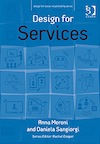Book: Design for Services
Series: Design for Social Responsibility
Authors: Anna Meroni and Daniela Sangiorgi
Gower Publishing, August 2011, 298 pages
In Design for Services, Anna Meroni and Daniela Sangiorgi articulate what Design is doing and can do for services, and how this connects to existing fields of knowledge and practice. Designers previously saw their task as the conceptualisation, development and production of tangible objects. In the twenty-first century, a designer rarely ‘designs something’ but rather ‘designs for something’: in the case of this publication, for change, better experiences and better services.
The authors reflect on this recent transformation in the practice, role and skills of designers, by organising their book into three main sections. The first section links Design for Services to existing models and studies on services and service innovation. Section two presents multiple service design projects to illustrate and clarify the issues, practices and theories that characterise the discipline today; using these case studies the authors propose a conceptual framework that maps and describes the role of designers in the service economy. The final section projects the discipline into the emerging paradigms of a new economy to initiate a reflection on its future development.
Contents:
Preface, Rachel Cooper
Introduction, Ezio Manzini
Section 1 Introduction to Design for Services: A new discipline
Section 2 Design for Services: from Theory to Practice and Vice Versa
Designing interactions, relations and experiences
CASE STUDY 1: Co-designing Services in The Public Sector
CASE STUDY 2: Developing Collaborative Tools in International Projects: Polidaido Project.
CASE STUDY 3: Designing Empathic Conversations about Future User Experiences
CASE STUDY 4: Driving Service Design by Directed Storytelling
CASE STUDY 5: Exploring Mobile Needs and Behaviours in Emerging MarketsDesigning interactions to shape systems and organisations
CASE STUDY 6: There is More to Service than Interactions
CASE STUDY 7: How Service Design can Support Innovation in the Public Sector
CASE STUDY 8: From Novelty to Routine: Services in Science and Technology-based Enterprises
CASE STUDY 9: Enabling Excellence in Service with Expressive Service BlueprintingExploring new collaborative service models
CASE STUDY 19: Service Design, New Media and Community Development
CASE STUDY 11: Designing the next generation of public services
CASE STUDY 12: A Service Design Inquiry into Learning and Personalisation
CASE STUDY 13: Mobile and Collaborative. Mobile-Phones, Digital Services and Socio-Cultural Activation.Imagining future directions for service systems
CASE STUDY 14: Using Scenarios to Explore System Change: VEIL, Local Food Depot
CASE STUDY 15: Designing a collaborative projection of the “Cité du Design”
CASE STUDY 16: Enabling Sustainable Behaviours in Mobility through Service Design
CASE STUDY 17: Supporting Social Innovation in Food NetworksA map of design for services
What is design for services?
What job profiles for a service designer?Section 3 Future Developments: An emerging economy
Appendices
Index
Authors
Dr Anna Meroni is assistant professor at the INDACO (Industrial Design, Arts, Communication and Fashion) Department of the Politecnico di Milano University, Italy, a Training and Research Centre in Design. She investigates service from the perspective of strategic social innovation, with a specific emphasis on community centred design. Her main research areas are food systems and innovative housing for sustainable lifestyles. Dr Meroni is co-director of the international Master in Strategic Design and a visiting professor and scholar in schools and universities around the world. She is active in the launch and promotion of the international network DESIS, Design for Social Innovation and Sustainability.
Dr Daniela Sangiorgi is a lecturer at ImaginationLancaster, the creative research laboratory at the Lancaster Institute for Contemporary Arts (Lancaster University, UK). As one of the early scholars looking into Service Design, she has gained international recognition. Her work has been mapping and supporting this emerging field of study and research since its outset. Her doctorate has investigated services as complex social systems, proposing holistic and participatory approaches to Service Design. Recent work has been exploring the role of Design and participation within public services reform, with a focus on commissioning for healthcare. She has been one of the founders of the Service Design Network and Service Design Research initiatives.
Contributors
Sara Bury, Computing Department, Lancaster University, UK
Keith Cheverst, Computing Department, Lancaster University, UK
Carla Cipolla, Department INDACO, Politecnico di Milano, Italy
Shelley Evenson, Carnegie Mellon University, USA
Luca Maria Francesco Fabris, Centro Metid and Dept. BEST, Politecnico di Milano, Italy
Giordana Ferri, Department INDACO, Politecnico di Milano, Italy
Julia Gillen, Department of Linguistics and English Language, Lancaster University, UK
Valerie Hickey, IBM Research USA and IBM Corporation, Canada
Stefan Holmlid, Linkoping University, Sweden
Johnathan Ishmael, Computing Department, Lancaster University, UK
François Jégou, Strategic Design Scenarios, Belgium
Sabine Junginger, ImaginationLancaster, Lancaster University, UK
Lucy Kimbell, Saìd Business School, University of Oxford, UK
Keith Mitchell, Computing Department, Lancaster University, UK
Dianne Moy, Melbourne University, Australia
Elena Pacenti, Domus Academy Research Centre, Italy
Margherita Pillan, Department INDACO, Politecnico di Milano, Italy
Nicholas J. P. Race, Computing Department, Lancaster University, UK
Bas Raijmakers, STBY, The Netherlands and UK
Mark Rouncefield, Computing Department, Lancaster University, UK
Chris Ryan, Melbourne University, Australia
Susanna Sancassani, Managing Director Centro METID, Politecnico di Milano, Italy
Giulia Simeone, Department INDACO, Politecnico di Milano, Italy
Paul Smith, Computing Department, Lancaster University, UK
Susan L. Spraragen, IBM Research USA and IBM Corporation, Canada
Deborah Szebeko, Think Public, UK
Nick Taylor, Computing Department, Lancaster University, UK
Paola Trapani, Department INDACO, Politecnico di Milano, Italy
Mark Vanderbeeken, Experientia, Italy
Roger Whitham, ImaginationLancaster, Lancaster University, UK
Jennie Winhall, Participle, UK




